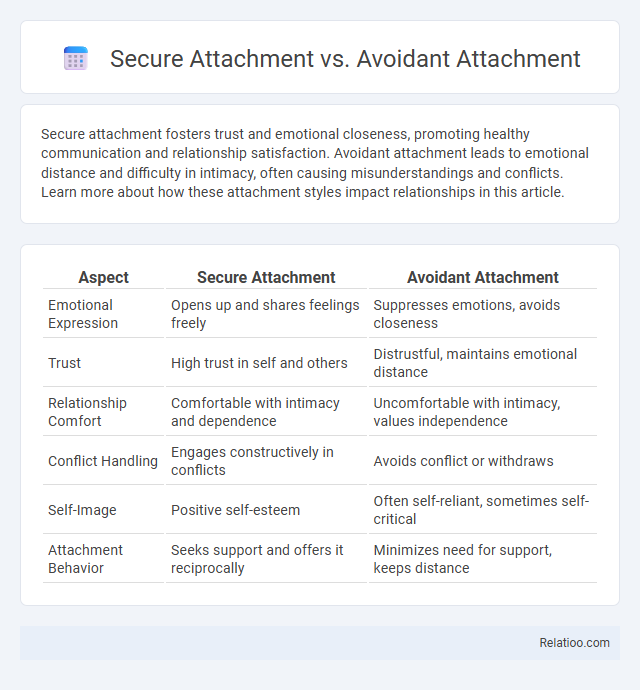Secure attachment fosters trust and emotional closeness, promoting healthy communication and relationship satisfaction. Avoidant attachment leads to emotional distance and difficulty in intimacy, often causing misunderstandings and conflicts. Learn more about how these attachment styles impact relationships in this article.
Table of Comparison
| Aspect | Secure Attachment | Avoidant Attachment |
|---|---|---|
| Emotional Expression | Opens up and shares feelings freely | Suppresses emotions, avoids closeness |
| Trust | High trust in self and others | Distrustful, maintains emotional distance |
| Relationship Comfort | Comfortable with intimacy and dependence | Uncomfortable with intimacy, values independence |
| Conflict Handling | Engages constructively in conflicts | Avoids conflict or withdraws |
| Self-Image | Positive self-esteem | Often self-reliant, sometimes self-critical |
| Attachment Behavior | Seeks support and offers it reciprocally | Minimizes need for support, keeps distance |
Understanding Attachment Theory
Understanding Attachment Theory reveals that Secure Attachment promotes healthy emotional bonds characterized by trust and balanced independence, whereas Avoidant Attachment involves emotional distance and reluctance to rely on others. The Dependency Paradox highlights that those who can comfortably depend on others actually develop stronger autonomy, while excessive avoidance undermines both connection and personal growth. Recognizing these patterns helps You foster meaningful relationships by addressing avoidance tendencies and cultivating secure attachments.
Defining Secure Attachment
Secure attachment is characterized by consistent responsiveness from caregivers, fostering trust and emotional stability in relationships. In contrast, avoidant attachment arises from caregivers' emotional unavailability, leading to emotional distance and self-reliance. The dependency paradox highlights how secure attachment enables healthy interdependence, whereas avoidant attachment results in a fear of dependence despite an underlying need for connection.
Defining Avoidant Attachment
Avoidant attachment is characterized by a strong desire for independence and emotional self-sufficiency, leading individuals to distance themselves from close relationships and suppress feelings to avoid vulnerability. This attachment style often results in challenges when forming secure bonds, contrasting with secure attachment, which fosters trust and openness. Understanding your avoidant attachment tendencies can help address the dependency paradox, where the fear of closeness coexists with a deep need for connection.
Key Differences between Secure and Avoidant Attachment
Secure attachment is characterized by comfort with intimacy and trust in relationships, allowing You to seek support when needed while maintaining independence. Avoidant attachment involves maintaining emotional distance and suppressing feelings to avoid vulnerability, often leading to difficulties in forming close bonds. Key differences include secure attachment's balance of closeness and autonomy versus avoidant attachment's tendency to prioritize self-reliance and emotional detachment.
Childhood Origins of Attachment Styles
Childhood experiences with primary caregivers critically shape attachment styles, where secure attachment arises from consistent, responsive caregiving promoting trust and emotional regulation. Avoidant attachment develops when caregivers are emotionally unavailable or dismissive, leading children to suppress attachment needs and exhibit self-reliance. The dependency paradox occurs when early inconsistent caregiving results in children simultaneously seeking closeness yet fearing dependence, reflecting a complex interplay of attachment anxiety and avoidance.
Behavioral Traits of Securely Attached Individuals
Securely attached individuals exhibit consistent emotional availability, effective communication skills, and balanced autonomy, fostering healthy relationships. Your ability to trust others and seek support without fear of abandonment highlights their resilience and emotional stability. These behavioral traits contrast sharply with the emotional distancing of avoidant attachment and the clinginess seen in dependency paradox cases.
Signs of Avoidant Attachment in Relationships
Signs of avoidant attachment in relationships include a consistent discomfort with closeness, frequent emotional distancing, and reluctance to share personal feelings or needs. Individuals with avoidant attachment often prioritize independence to an extreme, avoiding vulnerability and suppressing attachment desires. This behavior contrasts sharply with secure attachment, which embraces intimacy, and highlights the dependency paradox where the desire for connection conflicts with a fear of reliance on others.
Impact on Adult Relationships
Secure attachment fosters healthy communication and trust, allowing Your adult relationships to thrive with emotional stability and intimacy. In contrast, avoidant attachment often leads to emotional distance and difficulties in forming close bonds, creating challenges in maintaining long-term connections. The dependency paradox highlights the tension between the need for closeness and fear of dependence, often causing internal conflict and instability in relationships.
Strategies to Foster Secure Attachment
To foster secure attachment, consistently respond to emotional needs with sensitivity and reliability, promoting trust and emotional safety. Encourage open communication and validate feelings while setting clear boundaries to balance intimacy and autonomy. Implementing these strategies helps individuals avoid the pitfalls of avoidant attachment and the dependency paradox, cultivating healthier, more resilient relationships.
Overcoming Challenges of Avoidant Attachment
Overcoming challenges of avoidant attachment involves fostering emotional openness and building trust through consistent, supportive interactions that counteract tendencies to suppress feelings and avoid intimacy. Therapeutic approaches such as cognitive-behavioral therapy (CBT) and emotion-focused therapy (EFT) can help individuals recognize and modify avoidance patterns while reinforcing secure attachment behaviors. Strengthening communication skills and promoting vulnerability enables a shift from avoidant to secure attachment, reducing relational conflicts and enhancing emotional connection.

Infographic: Secure Attachment vs Avoidant Attachment
 relatioo.com
relatioo.com